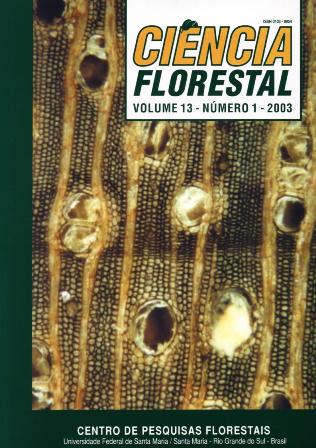USES AND VALUATION EVOLUTION OF THE TIMBER SPECIES FROM THE BRAZILIAN SEMI- -EVERGREEN FOREST OF ALTO-URUGUAI, SC
DOI:
https://doi.org/10.5902/198050981733Keywords:
genetic resources, species diversity, timber uses.Abstract
Species identification and their market value and price evolution since the colonization time of the remnants of the Brazilian Semi-Evergreen Forest (Floresta Estacional Decidual do Rio Uruguai) for potential timber production was assessed through 41 questionnaires, applied to timbermen and settlers from the surrounding region. The diversity of species for timber production commonly known by the people reached 63. From the 15 predominant species is relevant to mention Apuleia leiocarpa, Parapiptadenia rigida, Balfourodendron riedelianum, Nectandra megapotamica, Patagonula americana, Luehea divaricata, Cedrela fissilis, Ocotea diospyrifolia, Holocalyx balansae, Myrocarpus frondosus, Cabralea canjerana and Peltophorum dubium. The species with the highest commercial value were: Cordia trichotoma, Cedrela fissilis, Myrocarpus frondosus and Balfourodendron riedelianum. Data from the interviews suggest that several species from the Lauraceae family and Schefflera morototoni, Aralia warmingiana, Machaerium stipitatum, Chrysophyllum marginatum had an increment in use and commercial value during the last 15 years. Changing in the commercial value of a species was pointed out as due not only to the timber quality but also to the amount of the timber availability. Overall, it was detected that the species values changed across time and that the timber industry found several ways to adapt to the demands of forest products.
Downloads
References
COSTA, A.F. Studies on the effectiveness of a trihaloallyl as a new wood preservative against wood-decaying fungi. 1987. Dissertação (Mestrado) – Kyoto University, Japan, 1987.
COSTA, A.F. Utilização de interações entre produtos químicos preservantes no desenvolvimento de formulações para a prevenção de fungos manchadores e emboloradores na madeira. 1999. Tese (Doutorado) – Universidade Federal do Paraná, Curitiba, 1999.
HANSEN, J. IPBC – a new fungicide for wood protection. The International Research Group on Wood Preservation. 1984. (Doc. n. IRG/WP/3295).
JAPAN WOOD PRESERVING ASSOCIATION (JWPA) STANDARD 11 (1). Method for testing effectiveness of surface treatments (brushing, spraying and dipping) with termiticides against termites (1) Laboratory test. 1981.
MORISAWA, Y.; KATAOKA, M.; NAGAHORI, H.; SAKAMOTO, T.; NAKATA, Y.; KONISHI, K.; AIBA, T.; MIZUNO, T.; ONO, S.; MATSUNAGA, H.; NISHIMOTO, K. Synthesis and antifungal activity of trihaloallyl and trihaloacryl derivatives. Holzforschung, v. 38, p. 225-231, 1984.
SNOW, J.; COBHAM, P.; RYAN, N. Effectiveness of a newly registered antisapstain preservative in preventing stain of Eucalypt timber in Australia. The International Research Group on Wood Preservation. 2000. (Doc. n. IRG/WP 00-30229).
TAKAHASHI, M.; TSUNODA, K.; IMAMURA, Y.; ADACHI, A.; NISHIMOTO, K. Studies on the production of preservative-treated plywood. (1) Preservative effectiveness of glue-line treated plywood with low toxicity chemicals. Mokuzai Hozon (Wood Preservation), v. 11, n. 2, p. 11-24. 1985.
TSUNODA, K. JWPA method for testing effectiveness of surface coatings with preservatives against decaying fungi. The International Research Group on Wood Preservation. 1981. (Doc. n. IRG/WP/2164).
TSUNODA, K.; NISHIMOTO, K. Evaluation of wood preservatives for surface treatments. International Biodeterioration, v. 22, n. 27. 1986.







